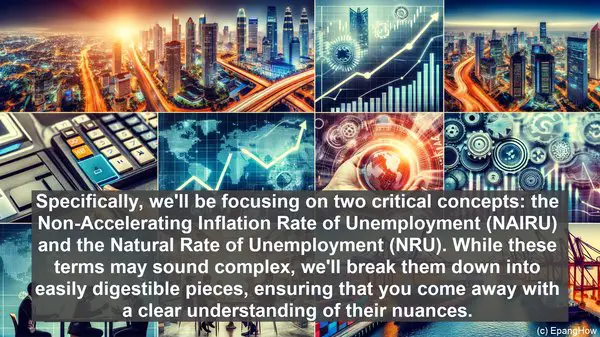Introduction: The Intersection of Unemployment and Inflation
Hello everyone! Today, we’re diving into the fascinating world of economics to explore the relationship between unemployment and inflation. Specifically, we’ll be focusing on two critical concepts: the Non-Accelerating Inflation Rate of Unemployment (NAIRU) and the Natural Rate of Unemployment (NRU). While these terms may sound complex, we’ll break them down into easily digestible pieces, ensuring that you come away with a clear understanding of their nuances.
Defining the Non-Accelerating Inflation Rate of Unemployment (NAIRU)
Let’s start by unraveling the intricacies of the Non-Accelerating Inflation Rate of Unemployment, often abbreviated as NAIRU. Put simply, NAIRU represents the lowest level of unemployment that an economy can sustain without causing inflation to accelerate. In other words, it’s the equilibrium point where the demand for labor matches its supply, ensuring a stable inflation rate. If the unemployment rate falls below NAIRU, it can lead to an increase in wages and, subsequently, higher prices, thereby fueling inflation. On the other hand, if unemployment surpasses NAIRU, it can result in deflationary pressures, as wages decrease, and consumer spending dwindles.
Unveiling the Natural Rate of Unemployment (NRU)
Now that we have a grasp of NAIRU, let’s shift our focus to the Natural Rate of Unemployment, or NRU. Unlike NAIRU, which is concerned with the inflationary impact of unemployment, NRU is more of a structural concept. It represents the level of unemployment that exists when an economy is operating at its potential output. In simpler terms, it’s the unemployment rate that prevails when all labor market frictions, such as job search and skill mismatches, are accounted for. NRU is often considered the ‘baseline’ or ‘normal’ rate of unemployment, as it’s not influenced by short-term fluctuations or cyclical factors.

Differentiating Between NAIRU and NRU
While NAIRU and NRU are related, they differ in their underlying principles. NAIRU, as we discussed, is primarily concerned with the inflationary consequences of unemployment. It’s a dynamic concept that can change over time due to various factors, such as technological advancements or shifts in labor market dynamics. On the other hand, NRU is more stable and represents the ‘steady state’ of unemployment. It’s influenced by structural factors, such as demographics or institutional arrangements, which change at a slower pace compared to the factors affecting NAIRU. In essence, NAIRU is a short-term concept, while NRU is more long-term in nature.

The Significance of NAIRU and NRU
Both NAIRU and NRU hold immense significance in the realm of economics. Understanding NAIRU is crucial for policymakers, as it helps them gauge the potential impact of monetary or fiscal policies on inflation. By ensuring that the unemployment rate remains close to NAIRU, policymakers can strive for price stability. NRU, on the other hand, provides insights into the structural health of an economy. A persistently high NRU may indicate underlying issues, such as a lack of skills or inadequate labor market flexibility, which can hinder long-term growth prospects. By addressing these structural challenges, policymakers can aim for a more efficient and productive labor market.
